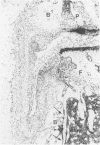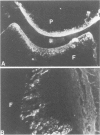Abstract
Intraarticular injection of cationic bovine serum albumin (BSA) induces a chronic arthritis in immunized mice, whereas the negatively charged native BSA fails to cause a protracted joint inflammation. In this study the authors examined the role of antigenic charge as a determinant of antigen retention and exact localization within the knee joint. Immune and nonimmune mice received an intraarticular injection of either radiolabeled native BSA (125I-BSA) or charge-modified BSA rendered cationic by amidation (aBSA), and autoradiographs were prepared of whole joint sections at various days after injection. As has been shown in the rabbit, the retention of the negatively charged native BSA is largely dependent upon the presence of antibodies. In nonimmune mice the radiolabeled antigen was hardly detectable after Day 1. In immune mice antibody-mediated retention of BSA was found in the ligaments and fibrous cartilage structures of the joint but appeared to be absent at the hyaline cartilage. In contrast, large amounts of the cationic aBSA were retained at all collagenous structures of the joint, the most striking observation being the deep penetration in the dense hyaline cartilage. This was found both in immune and nonimmune mice, which indicates that the deep penetration was not due to cartilage damage occurring under inflammatory conditions. With different dosages of aBSA it was found that the presence of antibodies may modulate the retention pattern in immune mice. Deep diffuse penetration into the dense hyaline cartilage, together with some surface labeling, was observed after injection of a high dose (60 micrograms), whereas mere surface labeling was found with the low dose (6 micrograms). Distinct superficial labeling was not seen in nonimmune mice, which suggests that this pattern represents immune complex formation at the cartilage surface. Immunofluorescence studies on undecalcified whole joint sections confirmed the deep penetration of the cationic antigen and supported the presence of immune complexes at the cartilage surface, because intense complement and Ig staining was detectable at this site. Our data indicate that antigenic charge determines the antigen retention in the joint both quantitatively and qualitatively. Negatively charged native BSA has no affinity for cartilage, high amounts of antibodies are needed for its retention in the joint, retention by this immune complex formation is largely restricted to the loose collagenous tissues, and the capacity to retain anionic antigen in the joint is therefore low.(ABSTRACT TRUNCATED AT 400 WORDS)
Full text
PDF










Images in this article
Selected References
These references are in PubMed. This may not be the complete list of references from this article.
- Adler S. G., Wang H., Ward H. J., Cohen A. H., Border W. A. Electrical charge. Its role in the pathogenesis and prevention of experimental membranous nephropathy in the rabbit. J Clin Invest. 1983 Mar;71(3):487–499. doi: 10.1172/JCI110793. [DOI] [PMC free article] [PubMed] [Google Scholar]
- Batsford S. R., Takamiya M., Vogt A. A model of in situ immune complex glomerulonephritis in the rat employing cationized ferritin. Clin Nephrol. 1980 Nov;14(5):211–216. [PubMed] [Google Scholar]
- Boerbooms A. M., van den Broek W. J., van Rens T. J., van de Putte L. B. 99mTc-pertechnetate uptake after total knee replacement in rheumatoid arthritis. Acta Orthop Scand. 1982 Feb;53(1):125–129. doi: 10.3109/17453678208992189. [DOI] [PubMed] [Google Scholar]
- Border W. A., Ward H. J., Kamil E. S., Cohen A. H. Induction of membranous nephropathy in rabbits by administration of an exogenous cationic antigen. J Clin Invest. 1982 Feb;69(2):451–461. doi: 10.1172/JCI110469. [DOI] [PMC free article] [PubMed] [Google Scholar]
- Consden R., Doble A., Glynn L. E., Nind A. P. Production of a chronic arthritis with ovalbumin. Its retention in the rabbit knee joint. Ann Rheum Dis. 1971 May;30(3):307–315. doi: 10.1136/ard.30.3.307. [DOI] [PMC free article] [PubMed] [Google Scholar]
- Cooke T. D., Hurd E. R., Jasin H. E., Bienenstock J., Ziff M. Identification of immunoglobulins and complement in rheumatoid articular collagenous tissues. Arthritis Rheum. 1975 Nov-Dec;18(6):541–551. doi: 10.1002/art.1780180603. [DOI] [PubMed] [Google Scholar]
- Cooke T. D., Hurd E. R., Ziff M., Jasin H. E. The pathogenesis of chronic inflammation in experimental antigen-induced arthritis. II. Preferential localization of antigen-antibody complexes to collagenous tissues. J Exp Med. 1972 Feb 1;135(2):323–338. doi: 10.1084/jem.135.2.323. [DOI] [PMC free article] [PubMed] [Google Scholar]
- Danon D., Goldstein L., Marikovsky Y., Skutelsky E. Use of cationized ferritin as a label of negative charges on cell surfaces. J Ultrastruct Res. 1972 Mar;38(5):500–510. doi: 10.1016/0022-5320(72)90087-1. [DOI] [PubMed] [Google Scholar]
- Fox A., Glynn L. E. Is persisting antigen responsible for the chronicity of experimental allergic arthritis? Ann Rheum Dis. 1977 Feb;36(1):34–38. doi: 10.1136/ard.36.1.34. [DOI] [PMC free article] [PubMed] [Google Scholar]
- Gall E. P., Gall E. A. Histopathogenesis of bovine serum. Albumin-induced arthritis in the rabbit. J Rheumatol. 1980 Jan-Feb;7(1):13–23. [PubMed] [Google Scholar]
- Glynn L. E. The chronicity of inflammation and its significance in rheumatoid arthritis. Ann Rheum Dis. 1968 Mar;27(2):105–121. doi: 10.1136/ard.27.2.105. [DOI] [PMC free article] [PubMed] [Google Scholar]
- HUNTER W. M., GREENWOOD F. C. Preparation of iodine-131 labelled human growth hormone of high specific activity. Nature. 1962 May 5;194:495–496. doi: 10.1038/194495a0. [DOI] [PubMed] [Google Scholar]
- Hasselbacher P., Nacht J. L., Labosky D. A., Steinberg M. E. Antigen-induced arthritis: an immunohistologic study of articular tissue and synovial fluid using the horseradish peroxidase technique. J Rheumatol. 1980 Sep-Oct;7(5):596–608. [PubMed] [Google Scholar]
- Hollister J. R., Mannik M. Antigen retention in joint tissues in antigen-induced synovitis. Clin Exp Immunol. 1974 Apr;16(4):615–627. [PMC free article] [PubMed] [Google Scholar]
- Ishikawa H., Smiley J. D., Ziff M. Electron microscopic demonstration of immunoglobulin deposition in rheumatoid cartilage. Arthritis Rheum. 1975 Nov-Dec;18(6):563–576. doi: 10.1002/art.1780180606. [DOI] [PubMed] [Google Scholar]
- Jasin H. E., Cooke T. D. The inflammatory role of immune complexes trapped in joint collagenous tissues. Clin Exp Immunol. 1978 Sep;33(3):416–424. [PMC free article] [PubMed] [Google Scholar]
- Jasin H. E. Mechanism of trapping of immune complexes in joint collagenous tissues. Clin Exp Immunol. 1975 Dec;22(3):473–485. [PMC free article] [PubMed] [Google Scholar]
- Lens J. W., van den Berg W. B., van de Putte L. B., Berden J. H., Lems S. P. Flare-up of antigen-induced arthritis in mice after challenge with intravenous antigen: effects of pre-treatment with cobra venom factor and anti-lymphocyte serum. Clin Exp Immunol. 1984 Sep;57(3):520–528. [PMC free article] [PubMed] [Google Scholar]
- Lens J. W., van den Berg W. B., van de Putte L. B. Flare-up of antigen-induced arthritis in mice after challenge with intravenous antigen: studies on the characteristics of and mechanisms involved in the reaction. Clin Exp Immunol. 1984 Feb;55(2):287–294. [PMC free article] [PubMed] [Google Scholar]
- Ohno O., Tateishi H., Cooke T. D. Pathogenesis of chronic inflammation in experimental ferritin-induced arthritis. IV. Immuno-electron microscopic techniques in the study of articular collagenous tissues. Arthritis Rheum. 1978 Jan-Feb;21(1):81–91. doi: 10.1002/art.1780210114. [DOI] [PubMed] [Google Scholar]
- Rijntjes N. V., Van de Putte L. B., Van der Pol M., Guelen P. J. Cryosectioning of undecalcified tissues for immunofluorescence. J Immunol Methods. 1979;30(3):263–268. doi: 10.1016/0022-1759(79)90100-5. [DOI] [PubMed] [Google Scholar]
- Snowden J. M., Maroudas A. The distribution of serum albumin in human normal and degenerate articular cartilage. Biochim Biophys Acta. 1976 May 28;428(3):726–740. doi: 10.1016/0304-4165(76)90204-x. [DOI] [PubMed] [Google Scholar]
- Stanescu R., Leibovich S. J. The negative charge of articular cartilage surfaces. An electron microscopic study using cationized ferritin. J Bone Joint Surg Am. 1982 Mar;64(3):388–398. [PubMed] [Google Scholar]
- Tew J. G., Mandel T. E., Rice P. L. Immune elimination and immune retention: the relationship between antigen retained in the foot and the elicitation of footpad swelling. Immunology. 1980 Jul;40(3):425–433. [PMC free article] [PubMed] [Google Scholar]
- van den Berg W. B., Kruijsen M. W., van de Putte L. B., van Beusekom H. J., van der Sluis-van der Pol M., Zwarts W. A. Antigen-induced and zymosan-induced arthritis in mice: studies on in vivo cartilage proteoglycan synthesis and chondrocyte death. Br J Exp Pathol. 1981 Jun;62(3):308–316. [PMC free article] [PubMed] [Google Scholar]
- van den Berg W. B., Lens J. W., van de Putte L. B., van Beusekom H. J. Antigen induced arthritis: antigen handling and chronicity of joint inflammation. Agents Actions Suppl. 1982;11:233–241. [PubMed] [Google Scholar]
- van den Berg W. B., van Beusekom H. J., van de Putte L. B., Zwarts W. A., van der Sluis M. Antigen handling in antigen-induced arthritis in mice: an autoradiographic and immunofluorescence study using whole joint sections. Am J Pathol. 1982 Jul;108(1):9–16. [PMC free article] [PubMed] [Google Scholar]
- van den Berg W. B., van de Putte L. B., Zwarts W. A., Joosten L. A. Electrical charge of the antigen determines intraarticular antigen handling and chronicity of arthritis in mice. J Clin Invest. 1984 Nov;74(5):1850–1859. doi: 10.1172/JCI111604. [DOI] [PMC free article] [PubMed] [Google Scholar]








